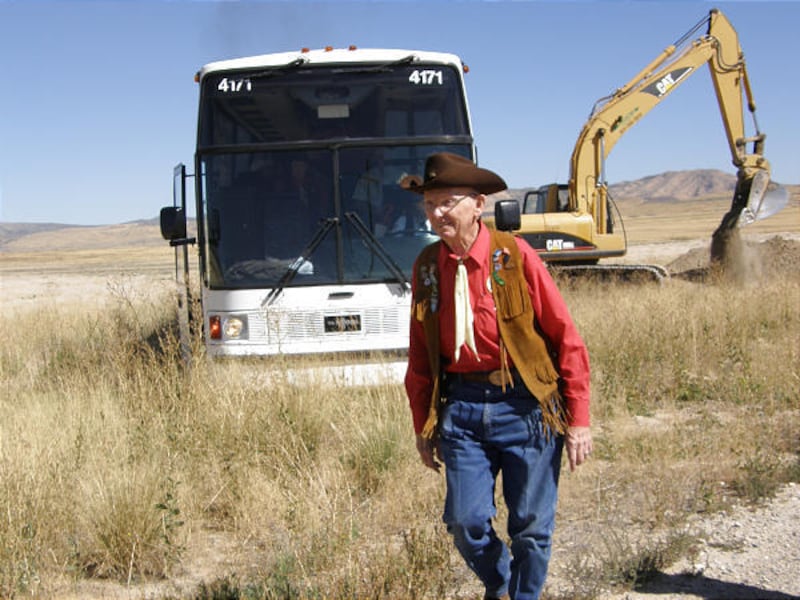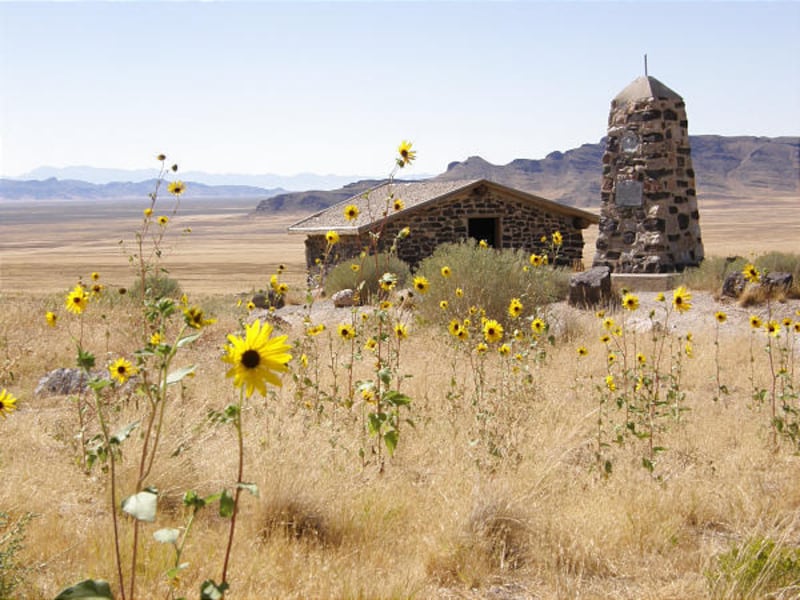PONY EXPRESS TRAIL — Joseph Hatch and Patrick Hearty are not just Pony Express history experts, but as re-enactors, they have often galloped down portions of the trail at a heady 10 miles-per-hour, their ponies kicking up dust in the desert air.
On Saturday, Hatch and Hearty traded their horses for a tour bus and led about 47 history enthusiasts in search of the original Pony Express trail — whether it led across asphalt, dirt or unpaved fields.
One hundred and fifty years ago, Pony Express riders sped through Salt Lake City either east towards St. Joseph, Mo., or west towards Sacramento, Calif. The overland mail service lasted from April 1860 to October 1861, when the telegraph's instantaneous information made 10-day-old news obsolete.
The bus tour left the Utah State Historical Society at the Rio Grande Depot (the site of this year's Utah State History Conference) at 8 a.m. A few minutes later, the bus passed a small Pony Express monument on Main Street. "I don't know why they put it there," Hearty said. "The Salt Lake House was at the Tribune Building." The Salt Lake House was a hotel and also a home station for Pony Express riders.
Riders would stay at the hotel and rest up before their next run — then off they would go, riding from station to station, changing horses — transferring the mochila, or mail pouch, until they reached the next home station, where the mochila was passed to a new rider and a new horse.
In addition to mail, the riders brought the "Pony Dispatch," fresh news from out East to be printed in the Deseret News.
The bus then followed the trail eastward toward Emigration Canyon, pausing at the Pony Express monument at This is the Place Heritage Park before continuing up the canyon — tracing the trail of the ponies and pioneers.
John Eldredge, an author and western trails expert, pointed out Mormon pioneer and Donner party sites along the way. Robert Voyles, director of the Ft. Douglas Military Museum, filled the tour in on military history.
Eldredge said the trail through Emigration Canyon was treacherous and included having to cross the river almost 20 times. The greatest hazards the tour encountered Saturday were bicyclists, parked cars, joggers and a set of cross-country skiers on rollerblade-like skis.
After stopping at another Pony Express station, the bus changed direction and drove down to State Street — the old Territorial Highway — and headed south. This was the route to California. Riders going west hurried to near Point of the Mountain where Porter Rockwell had a station. The buildings are gone, but a statue of Rockwell waved a hat as the bus drove by.
The trail continued toward Eagle Mountain — a community that celebrates Pony Express Days around the end of May each year. At one point, the bus left Pony Express Parkway and jogged over to a parallel dirt road. Off in the distance, Eldredge noticed something: A yellow Caterpillar excavator had dug an impassible trench across the dirt road. The bus came to a stop.
Eldredge and Hatch got out and surveyed the situation. They decided to blaze a new trail through the desert around the excavator. The bus headed into the weeds. Nothing stops the Pony Express.
After a lecture by Ft. Douglas Military Museum curator Ephraim Dickson, the group ate lunch at Camp Floyd (another station), and continued to other stations. One isolated station site had nothing but a pole marking its spot next to a scattering of sheds and some mobile homes. A few people stepped outside to gawk at a tour bus circumnavigating their remote desert homes. This obviously doesn't happen every day.
The tour was soon back on pavement, but not for long. It stopped at Point Lookout station. Porter Rockwell's brother, Horace, lived here with his wife Libby. There was a stone monument and, across the road, a small walled-in graveyard where Libby's precious dogs — long dead — are buried. An unseen dog barked nearby.
The bus moved on, skirting the Dugway proving ground as Voyles described modern artillery exercises.
The final destination was the Simpson Springs station. A rock cabin was built here by the Future Farmers of America in the mid-1970s over an original foundation. The trail continued westward — but the sesquicentennial Pony Express bus tour had finished its journey. The bus rumbled and squeaked along washboard bumps on the dirt road. Someone spotted an antelope. It proudly raised its head and long horns — watching as the tour headed home. In the distance was a herd of mustangs; wild horses kicking up dust in the desert air.
e-mail: mdegroote@desnews.com



